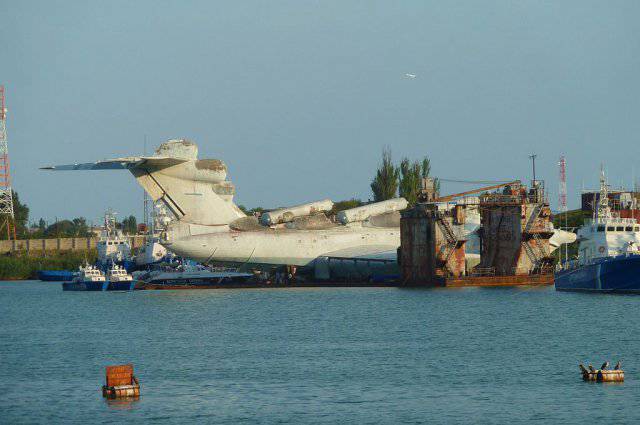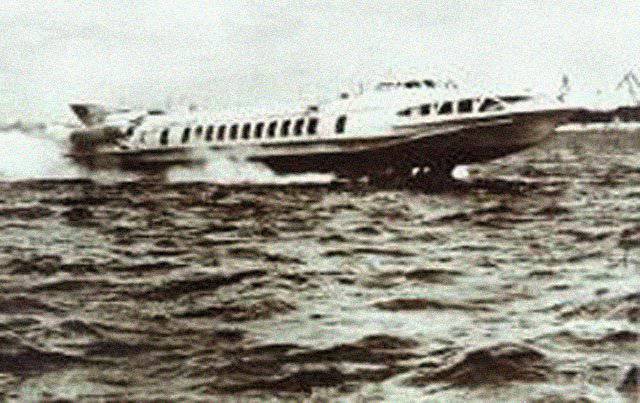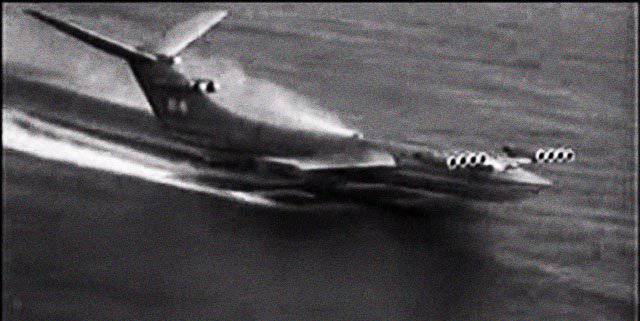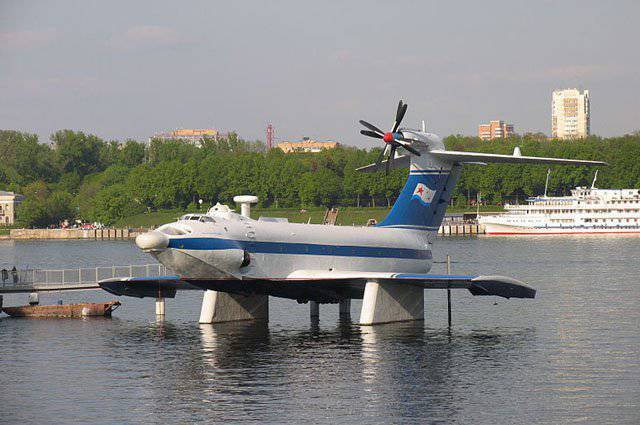Designer "flying ships". Genius and tragedy of Rostislav Alekseev
 The nightmare of the American admirals
The nightmare of the American admiralsGroup of american ships fleet led by an aircraft carrier carries out military service in the oceans. Radars do not detect any threats, and calmness reigns on American ships. It is disrupted by the sudden visual detection of a target on the horizon - either a ship rushing at incredible speed, or an airplane literally gliding over the surface.
An unidentified target in the eyes grows into a huge "flying ship". An alarm has been declared on the aircraft carrier, but late - a “stranger” performs a missile volley, and after a few dozen seconds the pride of the fleet, engulfed in fires and torn to pieces, goes to the bottom. And the last thing that dying sailors see in their lives is the rapidly shadowing shadow of an unknown and terrible enemy.
These or similar nightmares tormented at night the American military leaders who had information about the secret weapons USSR - shock ekranoplan "Lun" project 903.

An ekranoplan longer than 73 meters and almost 20 meters in height could travel at speeds up to 500 km per hour above the water surface at an altitude of about 4 meters. It was armed with anti-ship missiles "Mosquito", which allowed the enemy ships to inflict maximum damage. "Lun" got the nickname "aircraft carrier killer."
An amazing combat vehicle was developed at the Rostislav Alekseev Design Bureau, a Soviet designer, whose designs revolutionized shipbuilding.
Chasing speed
Rostislav Alekseev was born on December 18 on 1916 in the city of Novozybkov, Chernihiv Province, in the family of a teacher and agronomist. In 1935, Rostislav entered the Gorky Industrial Institute named after Zhdanov in the shipbuilding department.

In his student years, the future shipbuilder was fond of sailing. The young man thought about how to increase the speed of movement on the water.
At the very beginning of the era aviation pilots and designers drew attention to the so-called screen effect - a sharp increase in the wing lift and other aerodynamic characteristics of the aircraft when flying near the shielding surface (water, earth, etc.).
Engineers were looking for ways to use this effect in practice.
Rostislav Alekseev came to the conclusion that the way to increase the speed of movement on the surface of the water lies in reducing the area of contact of the vessel with the aquatic environment.
He started a young designer with the idea of a hydrofoil ship. Such a ship was for Alekseev the theme of his graduation project, which he defended in 1941.
The defense, held in July 1941, took place behind closed doors. The theme of the project Alekseev in the conditions of the outbreak of the war was more than relevant - “Speedboat with hydrofoils”. The idea of a high-speed combat boat for the needs of the Soviet Navy was highly appreciated.
The young engineer was sent to the Krasnoye Sormovo plant, where in 1942, Alekseev received premises and specialists to work on building combat boats on lightly submerged hydrofoils.
Alekseev did not have time to create unique combat boats before the end of the war, but his models were recognized as very promising. The work of the designer and his subordinates in 1951 was marked with the Stalin Prize of the second degree.

"Rocket", conquered the world
In 1951, the military workings of the young designer are transformed for the needs of civil shipbuilding. Alekseeva Design Bureau begins work on a passenger hovercraft, known as the “Rocket”.
The first “Rocket” was presented in Moscow during the World Festival of Youth and Students 1957 of the year. The passenger ship on hydrofoils, in its speed on its head surpassed all civilian ships that existed at that time, had the effect of a bombshell in the world.
"Missiles" have stepped far beyond the USSR. They were successfully exploited not only in the countries of the socialist camp, but also, so to speak, "in the lair of the enemy." Alekseev's ships confidently plowed the waters of Great Britain, Canada, Germany, Finland, etc.
Following the “Rocket”, other types of hydrofoil civilian ships were created, such as Volga, Meteor, Kometa, Sputnik, Burevestnik, Voskhod.
For this work, the team led by Rostislav Alekseev in 1962, was awarded the Lenin Prize.
"Caspian Monster"
But the designer did not think to rest on his laurels. Having fully implemented the idea of hydrofoil vessels, Alekseev proceeds to work on ekranoplans - ships hovering above the water surface.
In 1962, the Alekseev Design Bureau began work on the KM (a mock ship) project. “KM” had really gigantic dimensions - the wingspan of 37,6 m, length of 92 m, maximum take-off weight of 544 tons. Before the appearance of the An-225 “Mriya” aircraft, it was the heaviest aircraft in the world.
Western experts, having received a snapshot of the experimental model, called it the "Caspian monster" (the tests were held in the Caspian Sea).
His first flight "Caspian monster" made 18 October 1966 year. He was piloted by two pilots, one of whom was Rostislav Alekseev himself. The flight was successful.

Tests "KM" continued for 15 years. The new “flying ship” had a lot of advantages, however, there were enough flaws. In fact, "KM" opened up a completely new direction on the border of aviation and navigation, which still had to develop its own laws and rules.
"Frontier" position of wig affected their prospects in the most disastrous way. The Air Force believed it was a ship, and the shipbuilders were convinced that we were talking about an airplane. Alekseev, with his unusual project, caused irritation among officials who advocated the classic forms of shipbuilding development.
Alekseev’s chief curator of the Soviet defense industry, and later USSR Defense Minister Dmitry Ustinov, saved the project from complete closure.
"Orlyonok" and opal
In addition to official obstacles, there were problems with ekranoplan pilots. Pilots were extremely difficult to get used to pilotage, passing over the surface of the water. The special features of the WIG are such that it is almost impossible to “drop” it into the water during horizontal flight, even if you release the steering wheel altogether. However, professional habits of pilots were often forced to ekranoplan up, bringing it "off the screen," which caused accidents.
Each new failure was extremely painful both in the idea of a ground-effect vehicle and the designer Alekseev himself. In the 1968 year, the design bureau, which was created by him, was divided into two - by hydrofoil vessels and ekranoplanes. For Alekseev left only the second direction.
At the beginning of the 1970-ies, the Ministry of Defense gave an order to Alekseev’s design bureau to develop an amphibious landing vehicle for the Navy, which was given the code name "Orlyonok". In 1974, officials from Moscow literally forced Alekseev to bring another “raw” Orlyonok to sea trials even before receiving the results of a static body inspection. The result of this was the separation of the tail section of the hull during the tests. Alekseev, who traditionally drove his brainchild in his first flight, managed to safely return the Orlyonok to the base. No one was hurt, but Alekseev himself was punished to the fullest — he was removed from the development of the Orlyonok, transferred to the position of head of the advanced planning department.

Despite this, the detached designer almost underground continued to participate in the work on the landing ground-winged ekranoplane. In 1979, the "Orlyonok" was adopted by the Soviet Navy. This amphibious landing craft could take off at wave heights up to 2 meters and reach speeds of 400 – 500 km / h. Having taken on board up to 200 marines with full armament or two combat vehicles (tank, armored personnel carrier, infantry fighting vehicles), the Orlyonok could transfer them to a distance of 1500 km.
The designer killed his brainchild
In total, three combat "Orlyonok" were created, on their base the 11-I separate air group directly subordinate to the General Staff of naval aviation was formed. This series was to be the installation, but only in the Navy of the USSR was to join the military service 120 amphibious airplanes.
Despite the disgrace, Alekseev continued to work a lot - there were tests of the passenger wig, the development of a shock model armed with rockets continued ...
In January, the 1980 of the year in Chkalovsk was testing the passenger model of an airplane. His assistants cleared the ice block and said that the model could be released. What exactly happened at that moment is not certain. But Alekseev somehow assumed the weight of the 800-kilogram apparatus.
At first, it seemed that this incident did not affect the health of the 63-year-old designer - Alekseev successfully completed the test day. But the next morning, he began to complain of pain in his side. Doctors initially found it difficult to diagnose. So two more days passed, after which Alekseev fainted. During the emergency operation, the doctors found that the designer had been injured during the incident at the test - something that is commonly referred to in the people as “overstrained”. Over the past days has developed peritonitis. The doctors had to perform three operations and seemed to cope with the disaster. But complications began, and 9 February 1980, Rostislav Evgenievich Alekseev was gone.
Past and Future
The Lun impact ekranoplan, the design of which belonged to Alekseev, was launched in the summer of 1986, and in 1991, was officially accepted into service, becoming part of the Caspian Flotilla.
"Lun" remained the only impact wig of the Navy, first in the USSR and then in Russia. After the death of Dmitry Ustinov in 1984, his successor as Minister of Defense of the USSR, Sergei Sokolov, curtailed the program of building military E-wig, considering this type of weapon unpromising. And when, with the collapse of the Soviet Union, the Russian army was covered with total lack of money, Rostislav Alekseev’s revolutionary ideas were completely forgotten.
In 2007, the wig was finally written off from the Navy. At the same time, the most surviving instance of the landing Eaglet was towed down the Volga to Moscow, where it was installed in the Navy Museum.
The debate about whether the WIG has a future in the 21st century continues to this day. During the disputes, it became imperceptibly revealed that the fighting small-scale ekranoplans appeared in service with Iran and China. The Chinese soon intend to introduce a ground-winged wig, designed for 200 marines.
What does Russia need?
In Russia, work is currently underway on passenger small-displacement ekranoplanes, and the ideas of creating military vehicles of this type stumble upon the same resistance of officials of different ranks as they did during Rostislav Alekseev’s lifetime.
That's what a strange thing it turns out - in our country billions are easily allocated to buy Mistral helicopter carriers from France, and their own unique developments are just as easily sent to the basket or buried by endless approvals.
But only with reliance on our ideas and on our working hands can we guarantee the independence of the country.
And Rostislav Evgenievich Alekseev understood this like no other.
Information